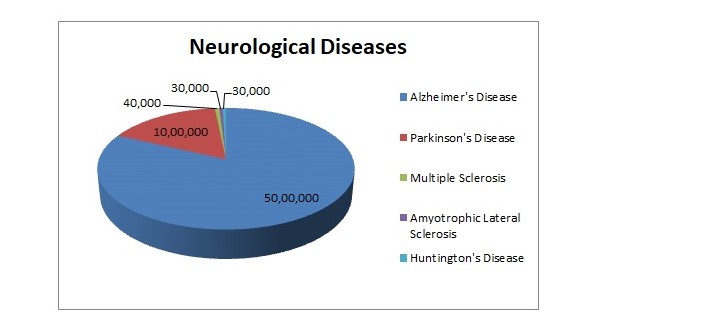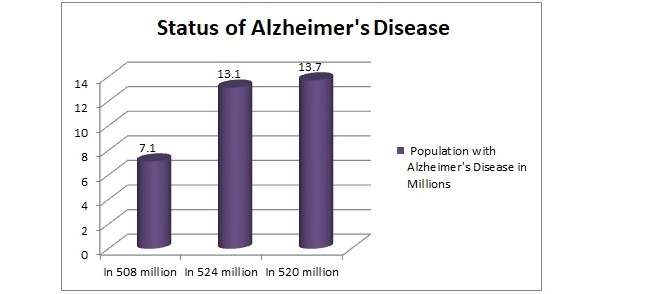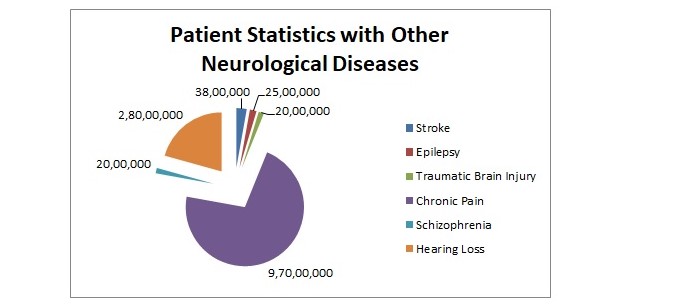Theme:
Neurodegenerative 2018
We take immense pleasure and great honour to invite all the participants from all over the world to attend the congress entitled “Neurodegenerative and Neuroinflammation conference: From Discovery to Health” held during October 18-20, 2018 at Helsinki, Finland
“Neurodegenerative congress 2018” aims at discussing the points that covers almost all the neurological disorders, their causes and therapies to diminish their source. We publish 700+ open access journals and organise 3000+ global events including 500+ participants with inspiring well-renowned speakers, eminent personalities, reputed scientists as board members and experts at global level.
This conference mainly handles the issues related to the brain diseases such as nerve damage and injuries, epilepsy, stroke , Alzheimer’s disease, Parkinson’s disease, migraine headaches etc…. According to the United Nations report nearly 6.8 million people are dying due to maladies each year. Up to one billion people, nearly one out of six of the world’s population suffers from neurological diseases. The study that was conducted by World Health Organisation clearly shows that the population is affected irrespective of the age, sex, education or income. Consequently this situation leads to high cost of those economic diseases in Europe countries reaching about €139 billion in 2004. Our congress joins hands with noteworthy and influential personalities to offer great solutions to these dreadful disorders.
Why to attend:
Conference Series llc LTD organises at most plenty of conferences to provide people a platform to learn and establish themselves. “Neurodegenerative conference 2018” based on the field of neurological disorders and treatments will definitely assure the participants to grab an opportunity to excel in their research works. It also provides a dais for the members attending the conference to make contacts with other delegates at the congress which will elevate their work levels to esteemed stage.
It furnishes a chance to gain innovative ideas to the students attending to achieve great. Students those who are not able to attend can make their presentations to appear at the conference through E-poster presentations. “Neurodegenerative 2018” benefits all the participants to make future collaborations, share their acquaintances, to get a move with clinical researchers and scientists to crack brilliant ideas in neurodegenerative world.
Target audience:
-Neurologists
-Neuropathologists
-Neurosurgeons
-Pharmacists
-Neurology Organisations and societies
-Professors and Research scientists
-Neonatologists
-Neuroscience Institutions
-Young researchers and students
-Neuroimmunologists
All researchers in the field of neurology.
Track-1: Nervous System and Nerve Injury:
Nervous system is one of the salient systems in our human body and its major function is to transmit the electrical signals to and from different parts of the body, in order to co-ordinate the body actions. Nervous system on the whole comprises of two classifications namely central and peripheral nervous system. Neurons are the structural and functional unit of nervous system. Central nervous system includes the brain and spinal cord, while the peripheral nervous system involves the nerves and ganglia outside brain and spinal cord that acts as a relay between brain, spinal cord and other body parts. The peripheral nervous system connects the central nervous system to other body parts. Injuries take place in both the nervous system depending upon the extent of damage.
- Nerve cell anatomy
- Central nervous system
- Peripheral nervous system
- Nerve pain and damage
- Nerve regeneration
- Impulse conduction and transmission
Track-2: Neurodegeneration and Neuroinflammation:
Neurodegeneration refers to the intense loss of the structure and function of neurons that leads to the death of neurons. It causes diseases that destroy the motor neurons, where motor neurons are the nerve cells that provide its own pathway involving the electrical impulses from brain to the spinal cord. Infections and traumatic brain injuries causes acute inflammation of central nervous system that is well known as neuroinflammation. Chronic inflammations are integrated with neurodegenerative diseases.
- Neuronal apoptosis
- Pro-inflammatory cytokines
- Estrogen receptors
- Amyotrophic lateral sclerosis
- Progressive dysfunction of neurons
Track-3: Neuropathology and Immunology:
A branch of neurology that is connected with the study of the tissues of the nervous system is termed as neuropathology. It is mainly concerned about the lesions or tumors inside the nervous system. The person who diagnose and treat the diseases connected with central nervous system are called neuropathologist. And now most of the neuropathologists are able to encounter the problems even when the patient is in the operating table. Neuroimmunology integrates the study of two complex systems, nervous and immune systems that assists neurologists to seek better knowledge during development, homeostasis and responses to injuries.
- Innate immune response
- Chronic inflammatory response
- Convergence of immune system
- Autoimmune disorder
- Forensic pathology
- Immunosenescence
- Brain histopathology
Track-4: Epigenetics in Nervous System:
Epigenetics in the nervous system is closely connected with the interactions between the epigenetic process that includes the regulation of gene expression without changing the sequence of DNA. Epigenetic mechanisms are the mediators of several functions inside the nervous system such as adult neurogenesis, neuroplasticity and it is also experienced in higher brain functions like cognition and memory.
- Neuronal glial differentiation
- Neuroplasticity
- Modulation of neural behaviour
- Neural stem cell fate
- Psychiatric disorders
Track-5: Neurological Disorders:
Neurological disorders involve any kind of disorders that arises in the nervous system. These disorders can be of structural, biochemical or electrical abnormalities in the brain, spinal cord, nerves of the peripheral nervous system that leads to a range of symptoms. Certain disorders in the nervous system cause loss of consciousness, sensory and mood changes. It has been found that there are more than 600 diseases of nervous system and a few major diseases are,
- Seizures and tumours
- Epilepsy and stroke
- Vascular disorders of nervous system
- Alzheimer’s disease and dementia
- Huntington’s and Parkinson’s disease
Track-6: Spine and Spinal Disorders:
Spine cord also called as swayback is composed of 26 bones known as vertebrae. The vertebrae protection to our spinal cord that gives us an erect posture. Certain problems such as injuries, tumours and infections can cause change in the structure of spine and damages the vertebrae as well. In addition to this any losing spondylitis and scoliosis are those factors that damage the surrounding tissues of the spine structure. Spinal disorders causes more pain when bone changes with age as the spinal cord or nerves are pressured much. Treatments depend upon the disease encounter that mainly includes back braces and surgery. The disabilities due to spinal disorders are caused mainly because of the impingement of the neural elements and thus surgeries are done to decompress the neural elements and to stabilize the spine elements.
- Vertebral framework
- Spinal epidural abscess
- Spinal cord tumours
- Stenosis of spine
- Spine rehabilitation exercises
Track-7: Brain Mapping:
The study of anatomy and physiology of brain through the use of imaging, cellular biology, nanotechnology etc... is known to be brain mapping. It is a technique that is based on the biological quantities and properties on to the spatial representation of the human or non-human brain that leads to maps. Collection of many different tools forms this kind of mapping. Still many parts are being developed by the scientists to build up this major mapping process. It involves the convergence of various brain images which is then turned into data and later analysed to check the brain functions. Brain mapping also called as mind mapping finds its major role in better analyzation, comprehension and to generate new innovative ideas.
- Optogenetics and neurophotonics
- Immunohistochemistry
- Neuro feedback
- Spatial representation of brain
- Neural imaging
- Cellular biology
- Cognitive brain mapping
Track-8: Neurofibramatosis and Neural Science:
A group of three conditions in the nervous system forms a genetic disorder called neurofibramatosis.The three conditions are neurofibramatosis-1, neurofibramatosis-2 and Schwannomatosis. Major causes for these conditions are the mutation that happens in the genes or in other cases it gets inherited from the parents of the patient. Instead developing the neurons the tumors help the supporting cells in their development. Tumors Neurofibramatosis-1 known as neurofibroma while f Schwann cells are involved in neurofibramatosis-2.On the other hand neural science is completely connected with the study of nerves and nerves system only. Through this study the growth of lesions and tumors inside the brain. Several organizations have been developed in order to provide a new forum to the scientists who do researches in the field of neuroscience.
- Genetic mutation
- Radiation and chemotherapy
- Neuronal circuits
- Neurofibroma
- Neurofibromatosis radiology
Track-9: Molecular Degeneration:
Molecular degeneration occurs in about 80,000 people and it is the common cause of adult blindness. Macular degeneration in brain results in the loss of certain important parts of eye namely retina and fovea. The progressive loss of vision in this area obviously causes input losses in the visual cortex of brain. Since this disorder mainly affects the central part of eye (macula) that is related to the central nervous system, there are certain treatments that are possible and work for degenerative diseases in the retina.
- Photo dynamic therapy
- Visual hallucinations
- Input loss in visual cortex
- Vision drop in retina and fovea
- Pathogenesis of brain edema
Track-10: Paediatrics and Childcare:
Paediatrics generally refers to the care infants, children and adolescents. It is very difficult to recognize and monitor a new-born’s brain rather than adults and children and thus the Division of Neonatology and the Division of Neurology at Children’s National Health System appeared together in 2004 to provide an exclusive Neonatal Neurology and Neurocritical Care program. Some of the neonatal issues include hypotonia, perinatal stroke, seizures, neonatal encephalopathy, and brain injuries. The person treating the new born infants are called as neonatologists and those infants with low birth weight, prematurity, congenital malfunctions are specially taken care under neonatal intensive care units(NIC’s).
- Paediatric emergency medicine
- Childhood hemiplegia
- Developmental paediatrics
- Brain malformations
- Neonatal intensive care unit
Track-11: Neurochemistry and Pharmacology:
The study of neurochemicals that are small peptides participating in neural activities. It also involves the study of neurotransmitters, psychopharmaceuticals and neuropeptides whereas the study of drugs that affects the functions of the cells in the nervous system and the neural mechanisms. Neurochemistry and pharmacology also has its diversities in cell injury and inflammation, neurodegenerative diseases, sensory transduction, neural processing, Gene regulation & genetics, Brain development & Cell differentiation. Neurotransmitters involved in the neurochemical study are the chemical messengers that are essential to transmit the signals from one neuron to another.
- Neuro chemical interactions
- Neuro transmitters
- Neuro genesis
- Neural modulators and co transporters
- Nerve action potential
- Molecular and behavioural pharmacology
Track-12: Neurosurgical and Modulation Therapies:
The treatments to neurosurgical disorders are performed by the neurosurgeons who are committed to a multidisciplinary verge on patient care. They ensure right diagnosis and treatment plan. Neurosurgical treatments are now providing new life to the patients, those who suffer from serious disorders such as epilepsy, brain and spinal tumours and stroke are given full hope for their treatment. Convincing surgical therapies includes cyber and gamma knife, nerve decomposition and reconstruction, deep brain stimulation and minimally invasive spine surgery. In addition to these treatments, various modulations therapies have been made that targets the nervous system and brain through electrical stimulation and also offers drugs to get rid of pain and to restore the lost function.
- Cochlear and retinal implant
- Invasive electrical methods
- Vagus nerve stimulation
- Electroceutical therapy
- Neuro surgery
- Neuro protection
Track-13: Neuro-Rehabilitation:
Neuro-rehabilitation is a compound medical process that aims at assisting in the recovery of spine injury or brain damage. The main purpose of rehabilitation is to reduce or to compensate for any functional losses in the nervous system. Neuro rehabilitation is concerned not only with the patient but also along with their families, that is their way of living, style and bodily changes that helps the affected patient to regain their lost factors. It focusses on the nutritional, psychological and creative aspects of a person’s recovery. A variety of therapies are offered to the victim such as conducting rehabilitation programs and teaching or re-training patients on mobility skills.
- Rehabilitation nursing
- Neuropsychology and social work
- Neural repair
- Neuro physiotherapy
- Speech and physical therapy
- Occupational and recreational therapy
Track-14: Computational Brain and Neural Engineering:
Computational brain and neural engineering has a strong anticipation towards the interface between brain and computers. Neural engineering draws attention on computational and experimental neuroscience, clinical neurology, and processing of living neural tissue and encircles certain elements from robotics, informatics, and cybernetics. Brain computation inculcates the mathematical models, theoretical analysis and abstractions of the brain to understand exact principles that controls the development and structure of the nervous system. These computational brain models are more useful since they capture the important features of the biological system multiple spatial-temporal scales. Visual perception, learning and memory, and sensorimotor integration are the major domains of this brain type models.
- Brain emulation
- Neuro informatics
- Biological neural networks
- Biomechanics of brain
Track-15: Clinical Trials and Case Reports:
Neurology deals with the diseases related to brain and spinal cord particularly in the central and peripheral nervous system. It incorporates a lot of disorders such as stroke, epilepsy, Alzheimer’s and Huntington’s diseases etc… This study includes the most serious and top most neurological diseases, their diagnosis and treatment procedures. Some diseases that relates to the case report studies are as follows.
- Transient ischemia attack
- Encephalopathy
- Analysis of inherited neurological disorders
- Traumatic brain injury
- Multiple sclerosis
-
Migraine headaches
We are privileged to invite all the participants from all over the world to attend the congress entitled “Neurodegenerative and Neuroinflammation conference: From Discovery to Health” held during October 18-20, 2018 at Helsinki, Finland
Deterioration of nerve system cells in brain and spinal cord causes neurodegenerative diseases. Any kind of changes in these cells leads to its abnormal function and in most cases it results in cells demise. As the neurons starts to deteriorate slowly the person will be unable to remember things and when the deterioration becomes aggressive it leads to major unconsciousness.
Neurodegenerative diseases are expected to arise primarily mid to later stage of life. About 5 million people in the population suffer from Alzheimer’s disease, 1 million from Parkinson’s and 40,000 from multiple sclerosis, 30,000 amyotrophic lateral sclerosis and 30,000 from Huntington’s diseases. In the upcoming years if this situation is being unchecked the number might increase to about 12 million in future. One out of every 5 persons will be hit by these fatal diseases.
In the recent years progressive steps have been taken by Harvard Neuro Discovery Center and many others in order to obtain ideas about these diseases. The US National Institute for Neurological Disorders and Stroke (NINDS) estimated in a 2006 report that about 50,000 new cases of Parkinson’s disease are diagnosed in the US each year. The total number cases that is treated in US is about 500,000
Around the world the statistics of neurological disorders are quiet inaccurate whereas the prevalence of Parkinson’s diseases in industrialized countries1% for people over 60 and an estimate of up to 4% for people with higher age groups. Similarly for Alzheimer’s disease the case was that 7.5 million people out of 508 million populations in 2013. Predictably this case will turn as 13.1 million out of 524 million in 2040. And by 2080 the scenario will be as 13.7 out of 520.



Why Finland, Helsinki?
Finland is a sovereign state with 5.5 million people and was considered a co-operative model state that did not oppose any proposals for a common EU defence policy. The bank of Finland often organises scientific conferences, workshops and research seminars some of which are arranged to provide connections between eminent people.
Conference Highlights:
- Nervous system and Nerve injuries
- Neurodegenerative and Neuroinflammation
- Neuropathology and Immunology
- Epigenetics in Nervous system
- Neurological disorders
- Spine and Spinal disorders
- Brain mapping
- Neurofibromatosis and Neural science
- Molecular degeneration
- Paediatrics and Childcare
- Neurochemistry and Pharmacology
- Neurosurgical and Modulation therapies
- Neuro-Rehabilitation
- Computational brain and Neural engineering
- Clinical trials and Case reports
Top universities in Finland:
- University of Helsinki
- University of Tampere
- Abo Akademi University
- University of Oulu
- University of Eastern Finland
- University of Jyväskylä
- Tampere University of Technology
- University of Turku
- Aalto University
- Lappeenranta University of Technology
Major Associations around the World:
- American Board of Psychiatry and Neurology
- American Neurological Association
- American Academy of Neurology
- Association of British Neurologists
- European Academy of Neurology
- Rice Center for Neuroengineering
- Migraine Action Association
- North American Spine Society
- Stroke Association
- British Neuropathological Society
- European Federation of Neurological Societies
- National Spinal Cord Injury Association
- National Hospital for Neurology and Neurosurgery
- Neurological Society of India
- World Federation of Neurology
- Canadian Headache Society
Conference Highlights
- Nervous System and Nerve Injuries
- Neurodegeneration and Neuroinflammation
- Neuropathology and Immunology
- Epigenetics in Nervous System
- Neurological Disorders
- Spine and Spinal Disorders
- Brain Mapping
- Neurofibramatosis and Neural Science
- Molecular Degeneration
- Pediatrics and Childcare
- Neurochemistry and Pharmacology
- Neurosurgical and Modulation Therapies
- Neuro-Rehabilitation
- Computational Brain and Neural Engineering
- Clinical Trails and Case Reports
To share your views and research, please click here to register for the Conference.
To Collaborate Scientific Professionals around the World
| Conference Date | October 18-19, 2018 | ||
| Sponsors & Exhibitors |
|
||
| Speaker Opportunity Closed | |||
| Poster Opportunity Closed | Click Here to View | ||
Useful Links
Special Issues
All accepted abstracts will be published in respective Our International Journals.
Abstracts will be provided with Digital Object Identifier by
